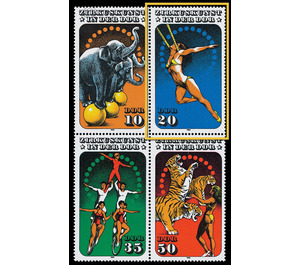Commemorative stamp series - Germany / German Democratic Republic 1985 - 20 Pfennig
Theme: Architecture
| Country | Germany / German Democratic Republic |
| Issue Date | 1985 |
| Face Value | 20.00 |
| Color | blue |
| Perforation | K 14 |
| Printing Type | Rotogravure 2 |
| Stamp Type | Postage stamp |
| Item Type | Stamp |
| Chronological Issue Number | 2726 |
| Chronological Chapter | GER-DDR |
| SID | 908890 |
| In 18 Wishlists | |
Circus Art in the GDR With representations from circus art in the GDR, the Ministry of Posts and Telecommunications of the German Democratic Republic issued four multi-colored special postage stamps in combination. Without special first day cover envelope special cancellation from 12 November 1985 to 11 January 1986 circus art in the GDR On 1 January 1985, the state circus of the GDR could celebrate its 25th anniversary. While in 1954 the three big circus companies "Eros", "Barlay" (today "Berolina") and "Busch" had become public property, the growing demands of cultural policy soon required central leadership. Thus, on January 1, 1960, the "VEB Central Circus", then in 1980, the mandatory name "State Circus of the GDR" was awarded. The circus art of the GDR has its roots in the progressive traditions of the German circus in the first half of the 19th century, which were founded especially by Christoph de Bach and Ernst Jacob Renz. Circus art is a very popular art. Over the past 25 years, around 57 million visitors have watched the programs at home and abroad. Twenty-five complete circus plays took place in socialist foreign countries. Ensembles also performed in France, Holland, the FRG and in 1984 a complete circus was performed in Greece. This year, there was a huge success in Japan. In addition, every year numerous individual performances in many countries of the world are required. The State Circus of the GDR today includes five carnivores, two elephant, six horse and seven pet and exotic dressings, thirty artistic performances, four clown groups and two orchestras. Traditionally, the dressage has a special status, the Dresseurnachwuchs is formed directly in the circuses. The young artists, on the other hand, are mostly graduates of the State College of Artistry. The special postage stamps document the program structure in the state circus of the GDR: 20 Pfennig - a solo work on the swinging rope, dominated here by gaiety, body control and aesthetics. "Unity of Diversity" is the key to the circus program, which appeals to so many and so many different visitors each year like no other art genre, and they all enjoy the achievements of circus performers time and again.


